Header Image from National Park Service Scotts Bluff National Monument, Nebraska.
Nebraska was admitted as the 37th state on March 1, 1867.
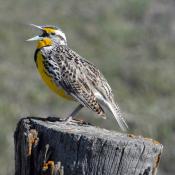 Bird: Western Meadowlark. The feathers on the breast of the Western Meadowlark are bright yellow with buff (light tan) tips. In autumn when the feathers are new, we see the feather tips, so the bird’s breast looks buff. By the time spring comes, the feathers are older and the buff-colored tips have worn away. So, in springtime the Western Meadowlark has a bright yellow breast.
Bird: Western Meadowlark. The feathers on the breast of the Western Meadowlark are bright yellow with buff (light tan) tips. In autumn when the feathers are new, we see the feather tips, so the bird’s breast looks buff. By the time spring comes, the feathers are older and the buff-colored tips have worn away. So, in springtime the Western Meadowlark has a bright yellow breast.
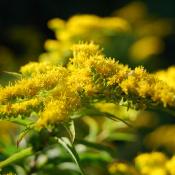 Flower: Goldenrods – Goldenrods are considered a sign of good luck or good fortune. As a natural remedy, goldenrod has been used to reduce pain and swelling (inflammation), as a diuretic to increase urine flow, and to stop muscle spasms.
Flower: Goldenrods – Goldenrods are considered a sign of good luck or good fortune. As a natural remedy, goldenrod has been used to reduce pain and swelling (inflammation), as a diuretic to increase urine flow, and to stop muscle spasms.
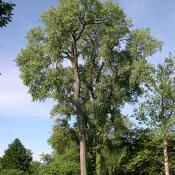 Tree: Cottonwood – Nebraska designated the cottonwood as the official state tree in 1972, replacing the original choice made in 1937 – the American elm.
Tree: Cottonwood – Nebraska designated the cottonwood as the official state tree in 1972, replacing the original choice made in 1937 – the American elm.
State Quarter
From theus50.com
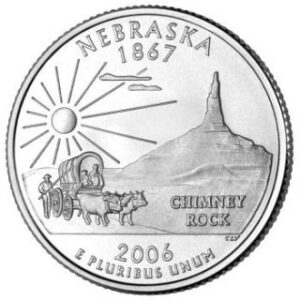
Nebraska’s quarter depicts an ox-drawn covered wagon carrying pioneers in the foreground and Chimney Rock, the natural wonder that rises from the valley of North Platte River, measuring 445 feet from base to tip. The sun is in full view behind the wagon. The coin also bears the inscriptions “Nebraska,” “Chimney Rock” and “1867”.
Chimney Rock was designated a National Historic Site on August 9, 1956, and is maintained and operated by the Nebraska State Historical Society.
Practically anywhere travelers go in Nebraska they will encounter reminders of America’s westward expansion. The state is crisscrossed by the Oregon and Mormon Trails, the Pony Express, the Lewis and Clark Trail, the Texas-Ogallala Trail and the Sidney-Deadwood Trail.
Gem: Blue Agate
Insect: Honeybee
Nebraska comes from the archaic Otoe Indian words Ñí Brásge (in contemporary Otoe, it would be Ñí Bráhge), meaning “flat water.” The words refer to the Platte River, which flows across the Cornhusker State.
Prior to its statehood, the Nebraska Territory had been sparsely settled but saw growth during the California Gold Rush in 1848, with a larger wave of settlers arriving as homesteaders in the 1860s. Although the territorial capital of Nebraska was Omaha, when it achieved statehood the seat of government was moved to Lancaster, which was later renamed Lincoln after President Abraham Lincoln, who had recently been assassinated.
Nickname: The Great American Desert, Tree Planter’s State, Cornhusker State (The state nickname used to be the “Tree Planter’s State”, but was changed in 1945 to the “Cornhusker State”. )
Motto: Equality before the law
Nebraska Facts and Trivia
The first European to arrive in Nebraska was likely Spanish explorer Francisco de Coronado in 1541. He claimed the land for Spain. It was over 100 years later, in 1682, that another explorer, Frenchman Robert Cavelier, claimed the land for France. Over the next century, the land would be claimed and fought over by the French, Spanish, and British.
In 1800, France controlled a large area of land west of the Mississippi River. In 1803, the United States purchased this area, including Nebraska, from the French as part of the Louisiana Purchase. American explorers Lewis and Clark traveled through Nebraska in 1804, mapping their trip and reporting back about the flat plains and large herds of bison they saw in Nebraska.
The United States established Fort Atkinson in Nebraska in 1819. It was the first army post built west of the Mississippi river. In 1823, a small fur trading post was built on the Missouri River. It became Bellevue, the oldest city in Nebraska and the first permanent settlement.
Early explorers considered Nebraska and the surrounding areas part of the great American desert. In the 1860’s the first wave of homesteaders poured into Nebraska to claim free land granted by the federal government. Many of these first Nebraskan settlers built their homes out of sod because trees were sparse on the grassy land.
Nebraska is the only state in the union with a unicameral (one house) legislature.
Nebraska is the birthplace of the Reuben sandwich.
In Nebraska cattle outnumber people by three to one.
Nebraska has the U.S.’s largest aquifer (underground lake/water supply. The Ogallala Aquifer, which lies beneath 174,000 square miles of eight states extending from South Dakota down to western Texas, provides almost all of the water for residential, industrial and agricultural use in the High Plains region. Two-thirds of the Ogallala’s total supply comes from Nebraska.
Nebraska has more miles of river than any other state.
Nebraska is where “Arbor Day” first began. In 1872, Julius Sterling Morton proposed the holiday to plant trees on April 10 of that year and to award prizes to the counties and individuals who planted the most trees on that day. Roughly one million trees were planted in Nebraska on the first Arbor Day. Therefore, in 1885 Arbor Day became a legal holiday in Nebraska and it was moved to April 22, the birthday of Julius Sterling Morton.
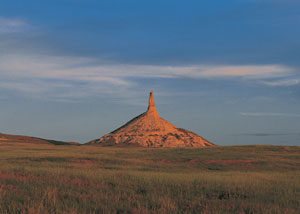 Chimney Rock is one of the most famous and recognizable landmarks for pioneer travelers on the Oregon, California, and Mormon Trails, a symbol of the great western migration. Located approximately four miles south of present-day Bayard, at the south edge of the North Platte River Valley, Chimney Rock is a natural geologic formation, a remnant of the erosion of the bluffs at the edge of the North Platte Valley. A slender spire rises 325 feet from a conical base.
Chimney Rock is one of the most famous and recognizable landmarks for pioneer travelers on the Oregon, California, and Mormon Trails, a symbol of the great western migration. Located approximately four miles south of present-day Bayard, at the south edge of the North Platte River Valley, Chimney Rock is a natural geologic formation, a remnant of the erosion of the bluffs at the edge of the North Platte Valley. A slender spire rises 325 feet from a conical base.
The cost of the Nebraska Capitol building was $ 9,800,440.07 in 1932. The construction job came in under budget and the building was paid for by the time it was completed.
Remember that little yellow-and-black booklet that got you through Julius Caesar? You have a Nebraskan to thank for those. Clifton Hillegass was a manager at Nebraska Book Company in 1958, when he bought a series of notes on Shakespeare from a Canadian book company owner named Jack Cole. Hillegass expanded the idea well beyond the Bard and eventually changed the name from “Cole’s Notes” to “CliffsNotes.”
Nebraska cities:
Cozad, Nebraska is located on the 100th Meridian where the humid east meets the arid west.
Spam (canned meat) is produced in Fremont.
The Naval Ammunition Depot located in Hastings was the largest U.S. ammunition plant providing 40% of WWII’s ammunition.
In 1927, the ever-popular juice drink Kool-Aid was invented by Edwin Perkins in Hastings, Nebraska. Perkins transformed his soft drink syrup “Fruit Smack” into the famous Kool-Aid powder, making for an easier shipping process.
The largest porch swing in the world is located in Hebron, Nebraska and it can sit 25 adults.
The 911 system of emergency communications, now used nationwide, was developed and first used in Lincoln, Nebraska.
Buffalo Bill’s Wild West show was formed in the little town of North Platte, Nebraska.
Father Edward Flanagan founded Boys Town in Omaha, Nebraska in 1917.
The Lied Jungle located in Omaha is the world’s largest indoor rain forest.
Marlon Brando’s mother gave Henry Fonda acting lessons at the Omaha Community Playhouse.
Mutual of Omaha Corporate headquarters is a public building built with 7 floors underground.
In Omaha, Nebraska you can find a six-foot-tall statue of the famous Chef Boyardee. Yes, the friendly face who graces the cans of Spaghetti-Os. And yes, he was a real person. Omaha is the former home of ConAgra Foods, Inc., which includes the Chef Boyardee brand.
Roy Rogers’ faithful horse, Trigger, died of natural causes in 1965—but you can still see him at RFD-TV in Omaha. Not a replica—the real Trigger. The stuffed and mounted horse was displayed at the Roy Rogers and Dale Evans Museum in Branson, Missouri, until 2010, when he was sold at auction where he brought in a whopping $266,500. RFD-TV uses Trigger for promotional events, along with Rogers’ dog, Bullet.
Strange Laws :
In Blue Hill, Nebraska, no female wearing a ‘hat that would scare a timid person’ can be seen eating onions in public.
It is illegal to sneeze or burp during church services.
Bars cannot sell beer unless they are also brewing a pot of soup.
Hotels are required to provide clean white cotton nightshirts for guests.
Condoms can only be sold by doctors.
People:
-
- Clayton Anderson, astronaut
- Fred Astaire, dancer, actor
- Max Baer, boxer
- Wade Boggs, baseball player
- Marlon Brando, actor
- Warren Buffett, investor
- Dick Cavett, TV entertainer
-
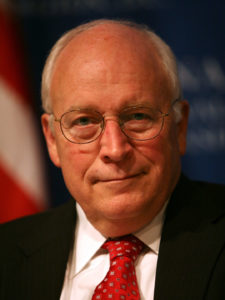 Former Vice President Richard “Dick” Cheney
Former Vice President Richard “Dick” Cheney
-
- Montgomery Clift, actor
- James Coburn, actor
- Edgerton, Harold, inventor of the strobe light
- Henry Fonda, actor
-
 Gerald Rudolph Ford, 38th U.S. president. He was born Leslie Lynch King Jr. in Omaha. His parents separated when the future President was only two weeks old. His mother married Gerald Rudolff Ford three years later.
Gerald Rudolph Ford, 38th U.S. president. He was born Leslie Lynch King Jr. in Omaha. His parents separated when the future President was only two weeks old. His mother married Gerald Rudolff Ford three years later.
- Bob Gibson, baseball player
- Hoot Gibson, actor
- “Gorgeous George” Wagner, wrestler
- L. Ron Hubbard, author, founder of Scientology
- David Janssen, actor “The Fugitive”
- Malcolm X, civil rights advocate
- Dorothy McGuire, actress
- Nick Nolte, actor
- Robert Taylor, actor
- Paul Williams, singer, composer, actor
- Roger Williams, pianist
- Darryl F. Zanuck, film producer
Credits:
See Mental Floss.com
See 50 states
See best things Nebraska.com
See State Symbols.org
See Only In Your State.com
See Ducksters.com
***Nelson, Ken. “Nebraska State History for Kids.” Ducksters, Technological Solutions, Inc. (TSI), www.ducksters.com/geography/us_states/nebraska_history.php. Accessed 17 February 2019.
See Tidbits of history.com/states for facts and trivia about each of the states.
